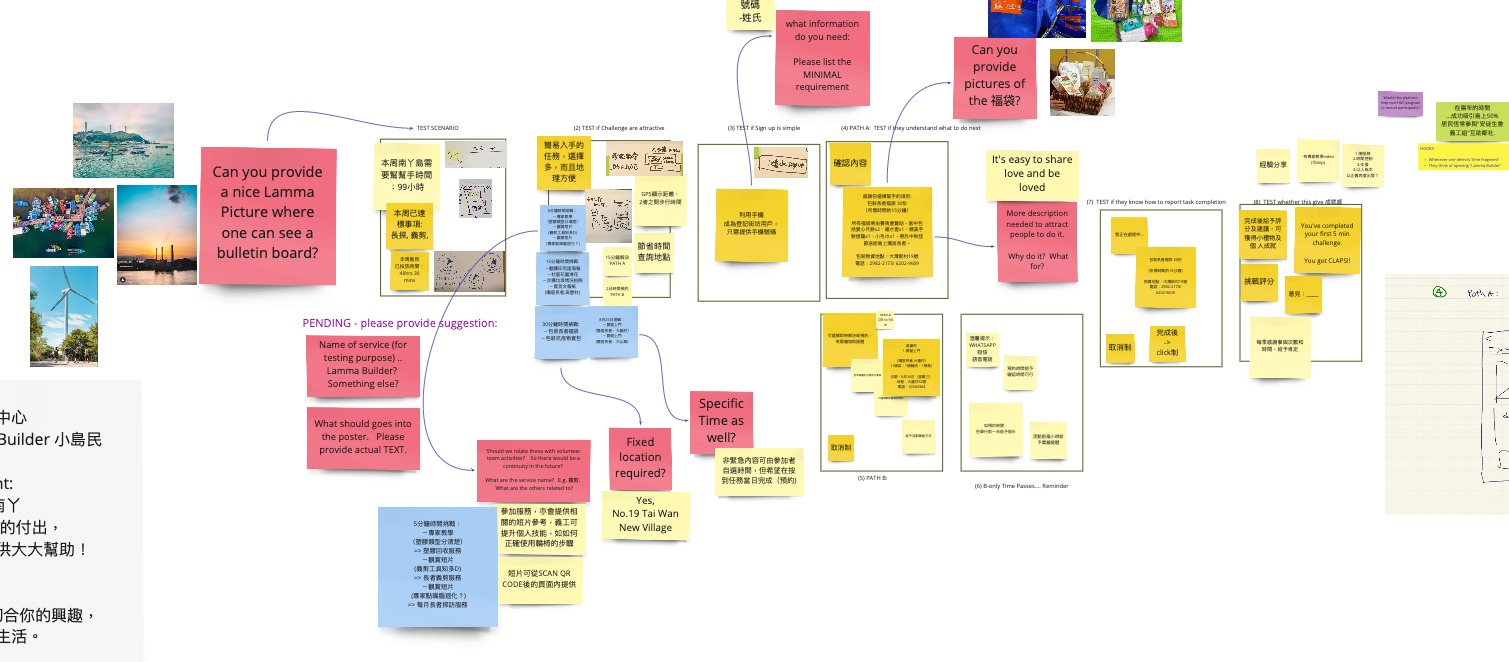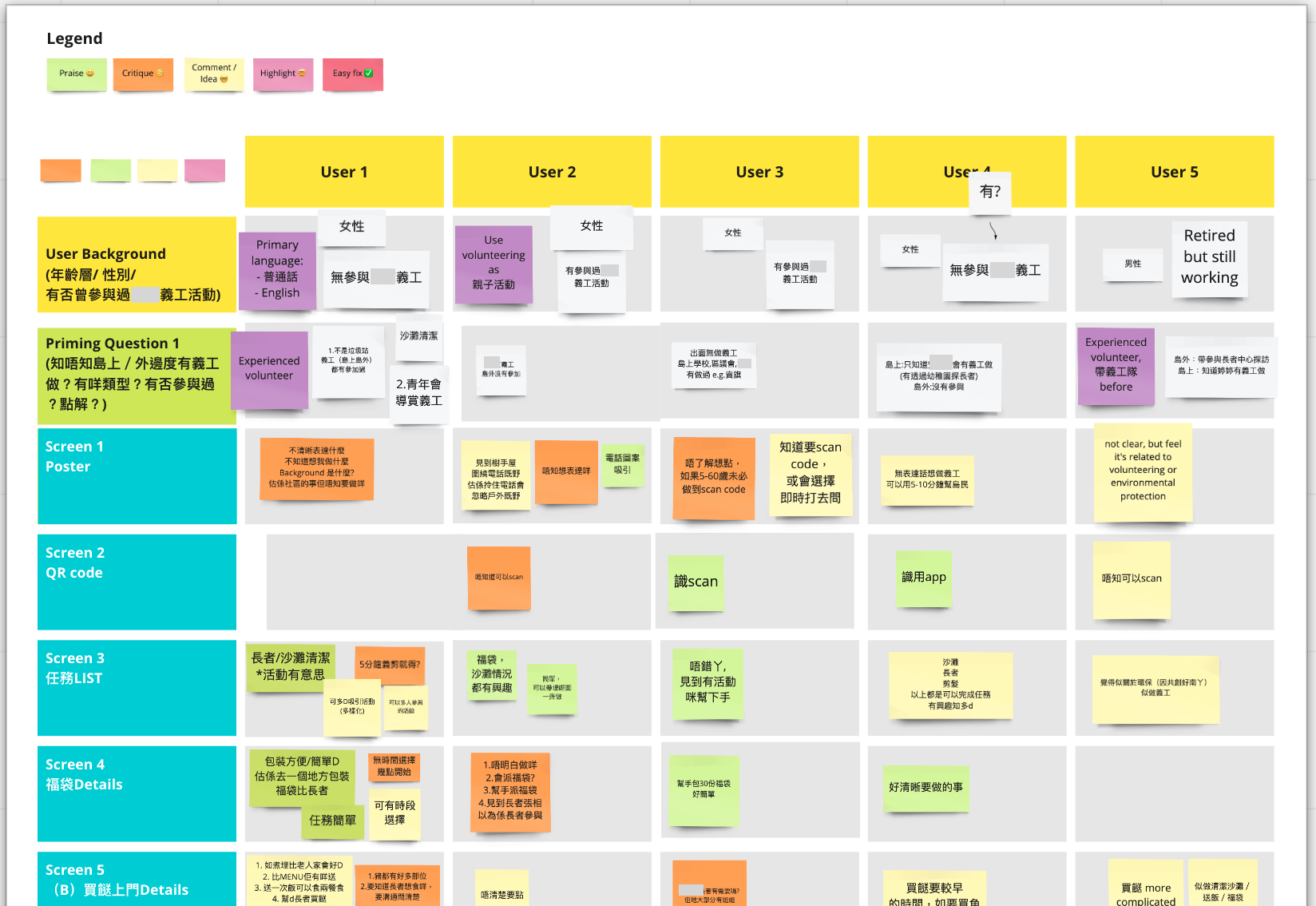"Time is running out ...", said the Executive Director of "Orange Dot" (code name), an NGO in Hong Kong with a long history of serving the community. In 4 months, the primary funding of one of their island centres would come to an end. It would mean service termination and centre closure if the centre cannot secure an alternative source of funding.
The island centre has been serving a multi-ethnic community of around 10,000 population, and they are the ONLY community service centre on that island. To avoid service termination, the staff members did everything they could - brainstorming, drawing mind-map analysis, trying to figure out the centre future. After many meetings, they struggled to come up with a substantial vision and program that could form the basis of a solid funding application.
"Let's run a Design Sprint to find a way out together." , I proposed to Orange Dot's Executive Director. My name is Wendy Tam, I'm the Founder of SprintImpact, a UX and Digital Product Studio specialized in Design Sprints. We believe Effective Co-Innovation is the key to unlock a team's potential, and Design Sprint is the proven framework for solving complex problem as a team.
This was the beginning of a Design Sprint journey that transformed the team and the future of the organization. We decided to run a 4-day Remote Design Sprint with the goal of developing a solid vision and plan which could lead to a successful funding application.
Pre-Sprint: Effort to pave the path to a highly productive sprint
For a fast-paced Design Sprint to run smoothly, we need to make every team member is ready to dive in as soon as we start on Day 1. This is why Pre-Sprint preparation so critical to a successful Sprint.
1) Put together a Sprint Team
The journey began with inviting members into a Sprint Team and helping them to understand what a Design Sprint is and what makes it so much more effect than the typical ways of solving problems with meetings and group brainstorming.
We had a 6-person Sprint Team with good diversity of domain knowledge, experience and perspective
- Decider: Executive Director of the organization. (time commitment: 2.5 days total)
- 4 members from the Island Centre: Centre In-Charge and 3 other Centre staff members. (time commitment: 3 days total)
Sprint Master: Myself. I also serve as:
- UX coach who led and instructed the team how to plan and conduct user testing.
- UX designer who worked closely with our prototype designer to create the high fidelity prototype creation.
Because we were running a Remote Design Sprint, we could respect social distancing and made it easy for those sprint team members to join the Sprint from the island.
2) Communicate with Stakeholders to begin with the end in mind
We started with an Initialization Session with the Decider and the Island Centre in Charge. We worked closely with stakeholders to show them how Design Sprints work. They also learned about the unique role of a "Decider", and how the process serves the Decider to make the best judgement and informed decision.
We presented the Design Sprint Challenge in writing, so that we could invite sprint members to discuss and to agree with what this Design Sprint set out to achieve.

3) Provide clarity and simplicity to the Sprint Team
We created a dedicated Workshop Page on Notion for the Sprint Team, where they can find all the information in one place:
The Sprint Schedule
- Dates & Time
- Day Planner (Localized into Chinese for easier understanding for team members)

- Sprint Goal & key outcomes.
- Video introduction of Design Sprints & how it is used to apply in their set of challenges.
- Link to Google Meet Video Call.
- Link to Miro Board - the remote whiteboarding tool.
4) Conduct one-on-one Pre-Sprint calls with each member
We invested in one-one-one Pre-Sprint Calls to set up each sprint member for success:
- We asked Sprint members to fill a "Pre-Sprint Survey" prior to attending the Pre-Sprint call. This allowed us to learn about their perspectives, questions or concerns, so that we could address them during the Pre-Sprint call.
- We asked them to join the Pre-Sprint call from the same location where they plan to take part the Design Sprint. By using the same set of equipments (computer, headset, WiFi) for the call, we can help identify if there is any potential setup or connectivity issue ahead of the sprint.
- We gave them a personalized introduction of what Design Sprint is, why it is different - including key concepts such as "Together Alone" and voting. We wanted to point out how Design Sprint provides the psychological safety that encourages worry-free participation.
- The Pre-Sprint call also allowed members to be familiar with using Miro - the digital whiteboard tool. Through mini activities, we can be sure they have no problem - Navigation around the Miro board, express ideas with post-it notes and use dot stickers for voting.
- Most importantly, we wanted to give our undivided attention to each sprint team member before the sprint began.
Design Sprint in action
Day 1 - Define the Challenge & Produce (lots of) Solutions
- Sprint Activities : Expert Interviews, HMW (how might we), Long-Term-Goal, Sprint Questions, Lightning Demos, 4-Part Sketching.
After the Sprint team has reached consensus with the Long Term Goal, we explored the riskiest assumptions and turned them into our Sprint Questions.

Using the Map, the Sprint Team was able to visualize the user journey and decide which part of the journey should be prioritized for the solution to focus upon.

Day 2 - Decide on concept to test and create Storyboard for prototype
Sprint Activities : Heat Map voting, solution presentation, straw poll vote, Decider Vote, User Test Flow, Storyboarding.
Day 2 started with a gallery of solutions submitted by individual team members from day 1.
The Sprint Team used the Storyboard to create the initial flow and content of the solution prototype

Day 3 - Building a tangible prototype; Recruit and schedule users for testing.
The big idea of the winning concept was "micro-volunteering". It set out to challenge people's perception that volunteering is only for those with plenty of idle time and energy. Our goal is to make it possible for everyone to became a volunteer - the project could make it easy for people to contribute and to feel good from their volunteering actions.
Note that although we presented the solution in the context of an App, the test is not about the usability of the app, but to validate if the proposed solution could answer our sprint questions.
Working with our prototype designer, we created high fidelity screen flows and a Marvel clickable prototype. The team continued to provide feedback by playing with the prototype on their phones.


Day 4 - The big day of learning & customer insights
Day 4 is all about answering the critical questions that we had set out on Day 1 of the Sprints:
- Q1: Can we attract residents from different background to join our program?
- Q2: Can we effectively engage volunteers to become more and more committed?
- Q3: Can we bring about a wide range of interesting volunteering experience?
The user testings took place at the island centre. We provided an intensive training for the Sprint members on the preparation and technique for conducting successful user interviews. We also showed them how to use color-coded post-it, to make it easy for sprint members to collect and analyze user feedback.

What did we learn from the user testing?
The team was amazed the amount of new customer insights got revealed through the user testing.
1 - People are eager to serve, but hindered by time commitment and ability concern: The core insight is that the act of volunteering is not merely an act of giving, but also an act of receiving. Through serving the community, it is a way for them to gain self-worthiness. The idea of micro-volunteering promises to reduce the barrier to participation, and we received a lot of positive support from testing.
2- Reveal a different "Jobs to be Done": We also learned that there are residents who 'hire' volunteering opportunities as parent-and-children activities for their kids. They would only be interested in those programs that serve that purpose. However, if they could not find any parent-and-children activities, they would lose interest in the volunteer platform altogether.
3 - Feedback on program details: Although the prototype was used to validate whether the big idea of micro-volunteering is desirable, the centre staffs learned a lot about the detail execution of potential volunteering programs. Take the example of "grocery delivery for elderly", testers raised concerns such as what kind of fish should they shop for them, other proposed the alternative of delivering a cooked dish instead. Centre staffs were delighted to have a means to learn from their users before the program is launched.
Answers to our Sprint Questions
Sprint Question #1: Can we attract residents from different background to join our program?
- Likely YES, testers responded positively to 'bite-size' volunteering opportunities which can make good use of their idle time.
- We proposed the team to run another round of testing with testers without any volunteer habit, the combined result would provide the team to a clear answer to this sprint question.
Sprint Question #2: Can we effectively engage volunteers to become more and more committed?
- Likely YES. Most testers expressed that they are interested in going back to the platform for more volunteering opportunities.
Sprint Question #3: Can we bring about a wide range of interesting volunteering experience?
- Not conclusion yet. The current prototype could not directly answer this question.
- During the interviews, we noticed that experienced volunteers were keen on sharing volunteering ideas. It shows the possibility of leveraging the platform to invite advanced volunteers to design and lead new activities, which would become a scalable way to host a wide range of volunteering experience.
Outcomes and transformation brought by the Design Sprint
Ownership, confidence and momentum
Because the vision & the solution was crafted by the entire team, everyone understands how it could lead them to the long term goal that they have envisioned. There is no more communication gap, or time spent on persuasion required for internal buy-in. The team knows exactly what they need to do to deliver the next meaningful progress.
Right after the Design Sprint, the team ran another round of user testing with people with no volunteer habits. The positive results from the 2nd testing gave them an additional boost of confidence that they are on the right path.
Meanwhile, the Centre in Charge took the initiative to work on a funding proposal based on findings and validations from the Design Sprint. The Executive Director was amazed by the energy, initiative and confidence that the team expressed through their actions. While they still need to work hard in securing the funding, they are now pursuing the funding challenge with strong motivation backed by market validation.
A transformation that goes a long way
With only 4 days of intense collaboration, the outcome of the Design Sprint goes a long way. In just a few weeks after the design sprints, the team was ready to submit a major funding application. Furthermore, the team was invited to submit another application to a funding source that shared their aspiration of the new program.
Kudos to the leaders who believe in Design Sprints and their teams to reinvent a better future.
Leaders don't create followers, they create more leaders. - Tom Peters

